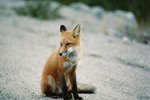
Rats are low on the food chain, meaning they make a tasty meal for many types of creatures. Some predators swallow them whole, while others take their time to savor the meal. For larger predators, rats may not be their first food choice, but they'll do in a pinch if other game isn't readily available.
Mammalian Munchers
Weasels, bold and aggressive in their hunting habits, enjoy noshing on small animals including rats. Many times they will kill more than they can eat, storing extra meat for later use. Coyotes help control rodent populations by including rats on their menu, but will also dine on small house pets if the opportunity presents itself. Red foxes are omnivores, and while they enjoy feasting on grasses and berries, they will gladly incorporate rats, mice and birds into their diet. Much like the weasel, the red fox will continue to hunt after he is full and store the leftovers for later. Mountain lions are apex predators, preying on the animals that hunt and eat rats, but they will hunt rats, mice and birds if other prey isn't readily available.
Slithery Swallowers
As its name implies, the rat snake's favorite meal is a rat. Generally harmless and choosing to freeze in place or flee if startled, rat snakes are very helpful for rodent control. These snakes are generally the ones most commonly found in urban areas, taking up residence in abandoned buildings or barns. Boas swallow their prey whole, including rats, but larger boas have been known to eat monkeys, pigs, and even deer. Both snakes are constrictors, squeezing their prey until it suffocates before eating it.
Bird Banquets
The red-tailed hawk is the second-largest hawk in North America, and likely the most commonly seen. Even in urban areas, they can be seen soaring above open spaces or perching on telephone poles. Their keen eyesight allows them to see the movements of their prey, such as a rat scurrying along a fence top. Barn owls prey on rats, hunting them at night. Soft, downy feathers muffle the sound of their flight, and acute hearing allows the owl to locate his prey by listening to it scurry about in the dark. The northern harrier, a slim hawk with an owl-like face, flies low to the ground, hunting prey by sound and feeding on small rodents such as rats and mice. The northern harrier will sometimes drown his prey in a nearby river before partaking of his meal.
Human Ruminations
Many human cultures include rats as a diet staple. In the southern United States, large rats called nutria are served up grilled or Cajun-style. In the Mishimi culture of India, women are only permitted to eat fish, pork, wild birds and rats. In Polynesian cultures rats were a traditional food. The Maori of New Zealand jealously guarded their rat populations and required strangers to obtain special permission from tribal leaders before hunting them.
References
- Encyclopedia Brittanica: Weasel
- The Humane Society of the United States: Coyote
- Nature Works: Red Fox - Vulpes vulpes
- National Park Service: Mountain Lions
- Savannah River Ecology Laboratory: Rat Snake
- San Diego Zoo Animals: Boa
- All About Birds: Red-tailed Hawk
- Animal Diversity Web: Tyto alba Barn Owl
- All About Birds: Northern Harrier
- Te-Ara: Story: Kiore - Pacific Rats
Photo Credits
-
Jupiterimages/Photos.com/Getty Images




